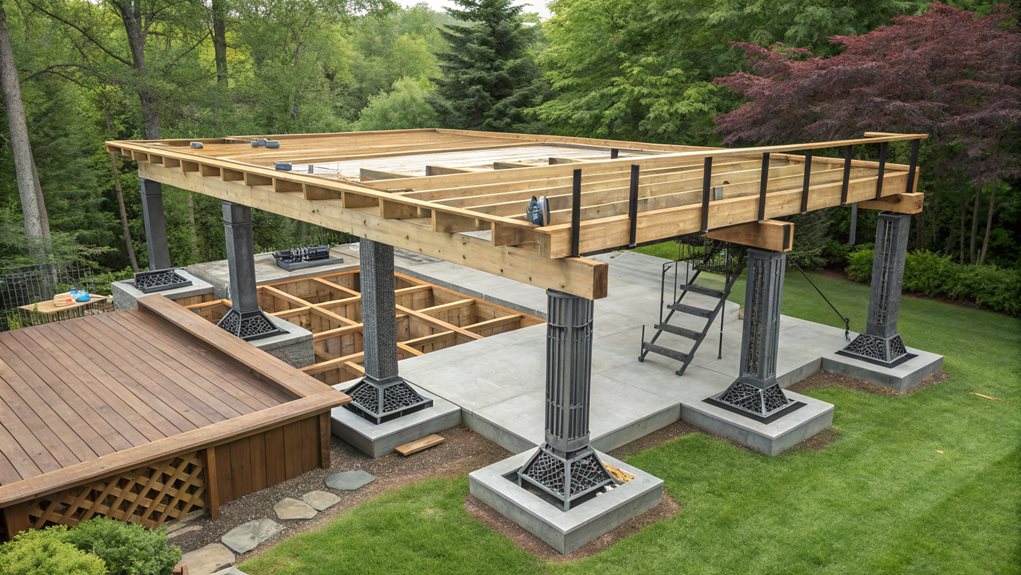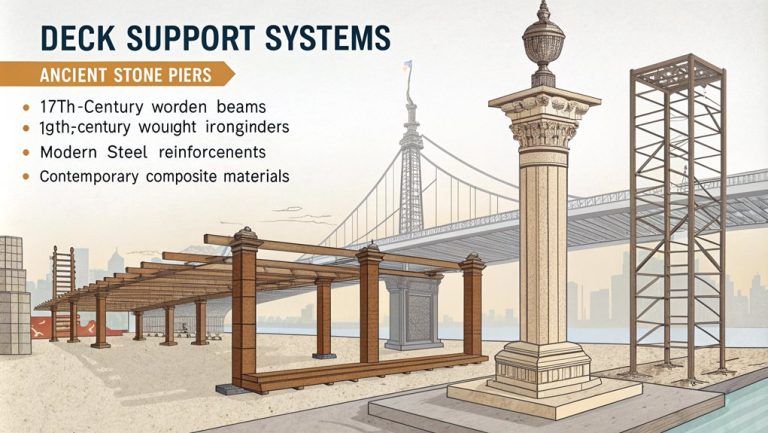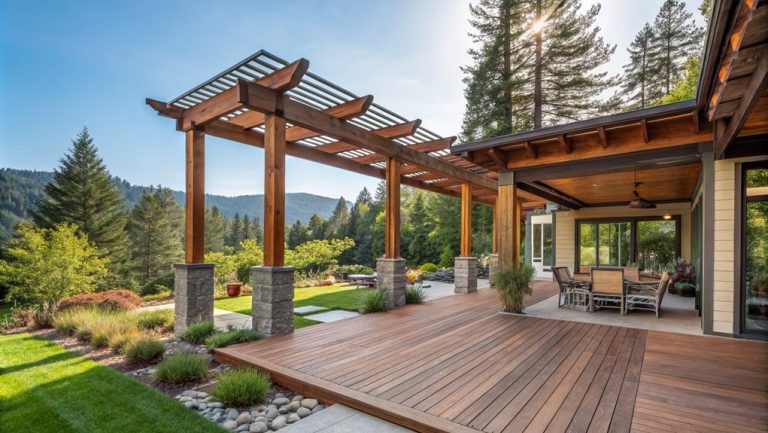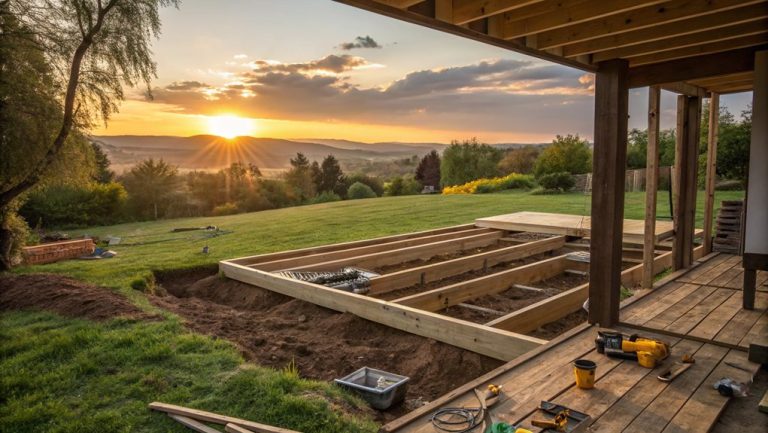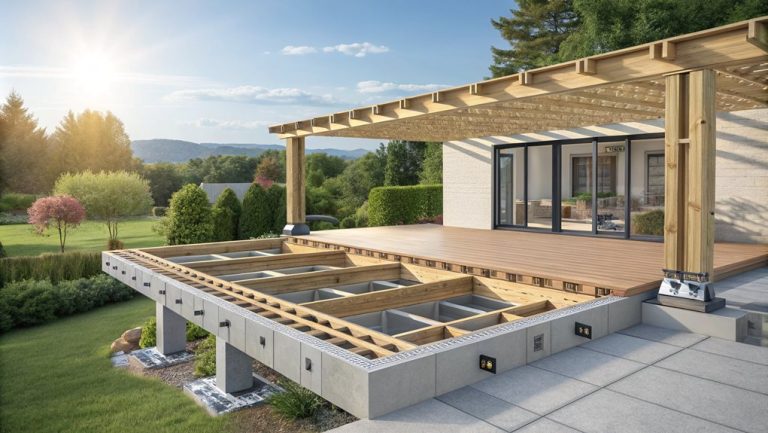How to Choose the Right Structural Support System for Your Deck
To choose the right structural support system for your deck, begin by examining footing and foundation options. Concrete footings are ideal for stability and frost heaving protection, while precast blocks suit simple, low-level decks. Material selection is imperative: pressure-treated lumber offers durability, steel provides unparalleled strength, and composite materials add moisture resistance. Consider beam and joist requirements, guaranteeing proper spacing and load capacity are met, essential for maintaining safety and integrity. Adjustable support systems can accommodate uneven terrain. Adherence to local building codes is critical to ensure compliance. Engaging with these aspects prepares you to make informed decisions ahead.
Expert Highlights
- Consider climate and soil type to ensure footings are below the frost line and distribute load effectively.
- Choose pressure-treated lumber for resilience, or steel for greater strength in larger structures.
- Ensure footings anchor the deck properly, distributing weight to provide stability in all conditions.
- Consult local building codes for compliance with material choices and structural requirements.
- Assess adjustable support systems for decks on uneven grounds or requiring height flexibility.
Assessing Footing and Foundation Options
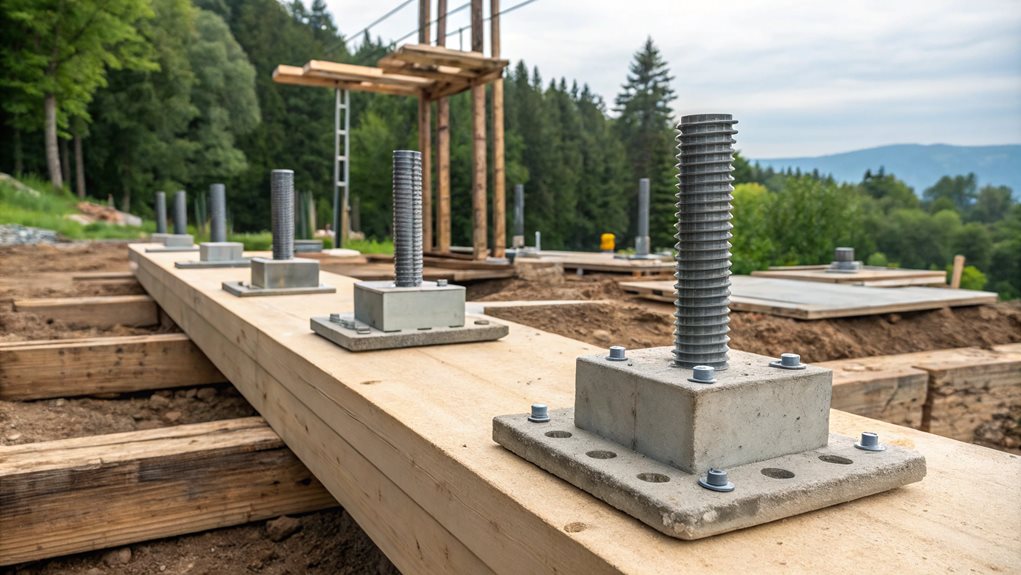
Evaluating footing and foundation options begins with understanding the different types of footings available, each with distinct characteristics and applications. Concrete footings, known for their stability, are essential for decks supporting heavy loads or those in colder climates where frost heaving poses a risk. They must meet local building codes and require curing time. In contrast, precast concrete pier blocks offer an immediate, budget-friendly solution for lower decks under 24 inches but lack stability in high-wind areas and may not be municipality-approved. Consideration of deck customization options, like material selection and outdoor living features, will influence the choice of structural support components. Discussing the suitability of deck support options with a professional contractor is crucial in ensuring that the selected system meets the project's specific requirements and adheres to all relevant codes. Climate and soil type dictate the necessary depth and width, ensuring footings are below the frost line and wide enough for load distribution. Proper installation and equipment usage are crucial, guaranteeing compliance and long-term structural integrity.
Selecting Appropriate Support Posts
Selecting the appropriate support posts for a deck is essential to guaranteeing its structural soundness and longevity. Material choice is pivotal; pressure-treated lumber is popular for its resilience to rot and insects, while steel provides unmatched strength for larger structures. Composite materials offer moisture resistance, but less commonly feature as primary support. Compliance with local building codes is indispensable when choosing materials. When constructing a deck, it's important to remember that footings anchor the deck to the ground, distributing its weight over a larger area to provide stability. Deck beams, also known as girders, support joists and distribute load across posts, ensuring the stability and strength of the deck's foundation. Placement and spacing of posts are equally critical. Posts should be positioned to effectively transfer loads from beams and joists to the footings, guaranteeing even weight distribution. Use post anchors that prevent rotations and provide stability, accommodating the entire deck load. Regular inspections and maintenance are necessary to maintain posts remain secure and free from deterioration. Incorporating eco-friendly materials into the construction not only benefits the environment but also enhances the longevity and aesthetic appeal of your deck.
Understanding Beams and Girders
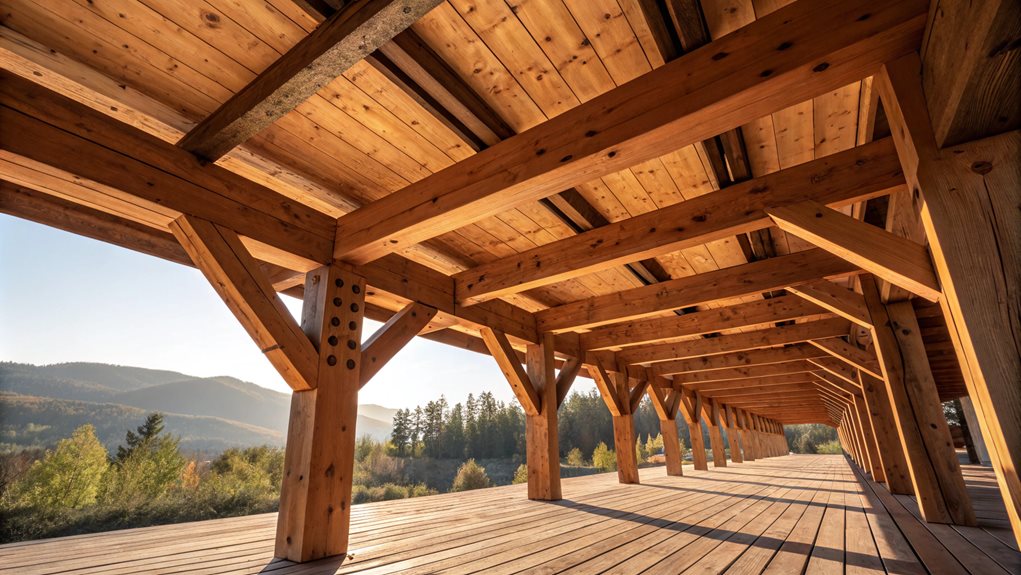
In deck construction, beams and girders serve as indispensable horizontal support elements that run parallel to the ledger board or the outer rim joists. These components provide critical support for the joists and deck surface, distributing the load evenly across support posts, thereby guaranteeing stability. The size and spacing of beams depend on the deck's dimensions, local building codes, and decking materials. Cedar decking is a popular choice due to its natural resistance to rot, decay, and insect damage, offering a longer-lasting and low-maintenance decking material option. Typically made from treated wood or steel, beams are positioned parallel to the house, often below joists, and secured to prevent sagging. Regular inspection for damage and level installation are vital to maintaining structural integrity. Beams work in conjunction with other structural components like posts and footings to ensure that the deck is not only functional but also safe and durable. Implementing connectors and hardware, such as steel connectors, is crucial to secure beams and girders properly. Compliance with building codes is imperative; consult local authorities to fulfill all support elements' requirements for safety and durability.
Determining Joist Requirements
When constructing a deck, determining the correct joist requirements is essential to ensuring structural integrity and safety. This involves careful consideration of several key factors:
- Calculating Joist Spacing: Standard joist spacing is typically 12 to 16 inches on center. For diagonal board layouts, reduce spacing to 12 inches to handle the increased distance boards must span.
- Considering Material and Load: Wood type greatly influences spacing due to varying strength; stronger wood supports wider spacing. Additionally, the expected load, including guests or equipment like hot tubs, impacts joist requirements. Proper joist selection and installation are crucial for floor safety and performance. For decks that are elevated, the position affects the necessary support posts and beams required. It is also important to seek guidance from licensed deck construction professionals who understand the nuances of structural requirements.
- Joist Sizing: The joist width can be calculated using the formula (Joist Span ÷ 2) + 2. Double thickness nearly doubles the possible span.
- Compliance with Codes: Always adhere to local building codes for sizes and materials to maintain structural soundness.
Exploring Adjustable Support Systems
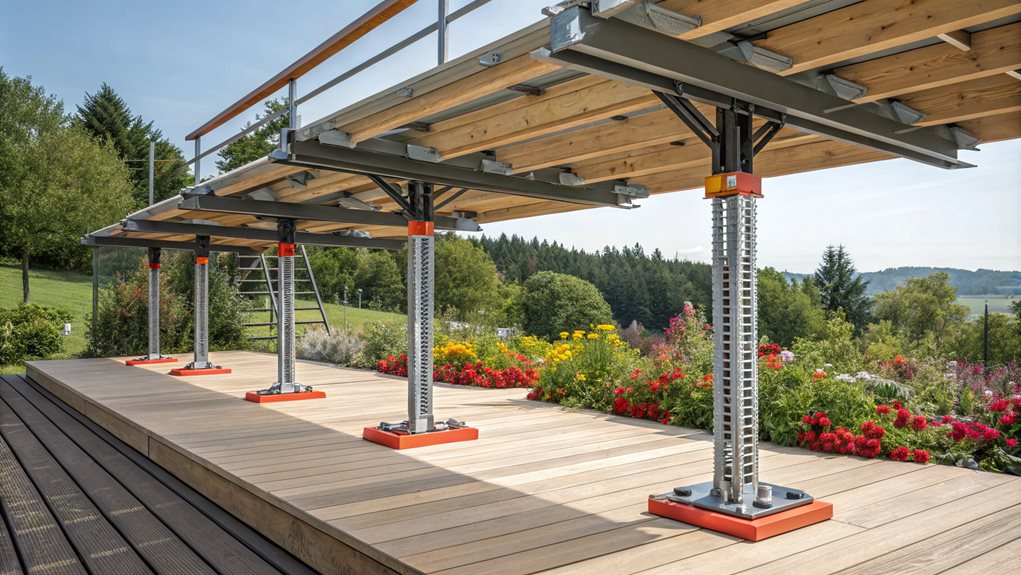
Exploring adjustable support systems for decks involves understanding the various types available, such as Eterno 'SE', Bison Level.Up, and Versadjust™, each offering different load capacities and height adjustability. The Bison Level.Up features a unique design with components like the Adjustable Pedestal and Floating Foundation Base, allowing for easy height and slope adjustment without the need for tools. Installation of these systems requires careful consideration of substrate conditions, slope compensation, and material quality to guarantee stability and longevity. Selecting the right support system is crucial for maintaining the overall design and integrity of the structure. The benefits of employing adjustable supports include the ability to maintain a level decking surface on uneven ground and accommodate heavy loads, though it's important to evaluate the specific requirements and limitations of each system before selection. Eterno SE supports can handle loads of over 2000 lb, adding an extra level of durability and reliability for deck installations.
Types of Adjustable Supports
Adjustable pedestal systems stand as a versatile and essential solution for efficiently supporting various decking surfaces. They offer remarkable height adjustability, ranging from a mere 1 1/4" up to an impressive 16 1/2". This guarantees ample flexibility in design and installation.
The choice of materials, such as plastic, aluminum, and steel, extends durability options while catering to different budget brackets. Many pedestals are equipped with advanced features like self-leveling capabilities and substantial load-bearing capacities, often supporting up to 1,000 pounds per unit.
Notable types include:
- Archatrak 'Prime' Series: Simplifies installation with three sizes covering significant height ranges.
- Eterno 'SE' Series: Self-leveling mechanisms enhance adaptability.
- Bison Level.It: A high-capacity, high-density polypropylene model.
- Fixed Height Rubber Pads: Ideal for low-elevation needs.
Installation and Requirements
Guaranteeing the stability and longevity of deck structures begins with proper installation and adherence to specific requirements. Footings, integral for foundation support, must meet precise standards. Positioned a minimum of 24 inches below grade, footings should remain below the frost line, anchored on solid ground. Posts, ideally 6×6 inches, serve as reliable load bearers from beams to footings, offering enhanced durability even beyond heights of 8 feet. Embedding posts ensures greater stability against lateral forces and uplift. Strategic bracing and blocking further fortify deck resilience, safeguarding against movement.
| Component | Specifications | Requirements |
|---|---|---|
| Footings | 22" diameter or 20" square | Below frost line, solid ground |
| Posts | 4×4" to 8', 6×6" beyond | Embed for stability, added durability |
| Ledger Board | Pressure-treated, 2×8 inches | Flashing and secure attachments |
| Bracing/Blocking | Diagonal cross-bracing required | Full-depth, secured with rated nails |
Benefits and Considerations
In recent years, adjustable deck support systems have emerged as a highly advantageous option for construction projects involving decks and rooftops. They offer unparalleled benefits and considerations that accommodate various project needs effectively.
Ease of Installation: Adjustable supports reduce labor and material needs, streamlining the construction process for a more cost-effective project.
Versatility and Compatibility: These systems are compatible with materials such as concrete pavers and ipe wood tiles, making them suitable for both outdoor decks and rooftop applications.
Leveling and Stability: They offer self-leveling capabilities, addressing sloped and uneven terrains, ensuring stable and level surfaces.
Long-Term Economic and Environmental Benefits: Adjustable systems help prolong roof lifespan, regulate temperature, and dampen noise, contributing to cost-efficiency and sustainability.
This versatility instills confidence, enhancing belonging within the builder community.
Evaluating Decking Material Compatibility
Selecting the right decking material involves evaluating its compatibility with various structural support systems to guarantee safety and durability. Composite decking stands out due to its lightweight nature, adapting well to support systems such as pre-cast concrete pier blocks or concrete piers, offering moisture resistance and reducing decay risk. Traditional wood decking, in contrast, necessitates sturdy, moisture-protective systems like flashing or self-adhesive tapes. Ensuring proper alignment with the load capacity of the support system prevents structural failures, especially with heavier materials. Ground screws and adjustable supports offer long-term stability and adaptability, whether accommodating a herringbone design or concealed fasteners.
In waterfront settings, structural support systems are crucial for ensuring the longevity of decks that must withstand fluctuating water levels and coastal conditions.
| Material Type | Compatible Support System |
|---|---|
| Composite | Concrete piers, ground screws |
| Traditional Wood | Robust concrete footings |
| Scalloped Composite | Pre-cast concrete pier blocks |
| Moisture-Resistant | Helical piles |
| Solid Composite | Adjustable deck supports
Adhering to Local Building Codes
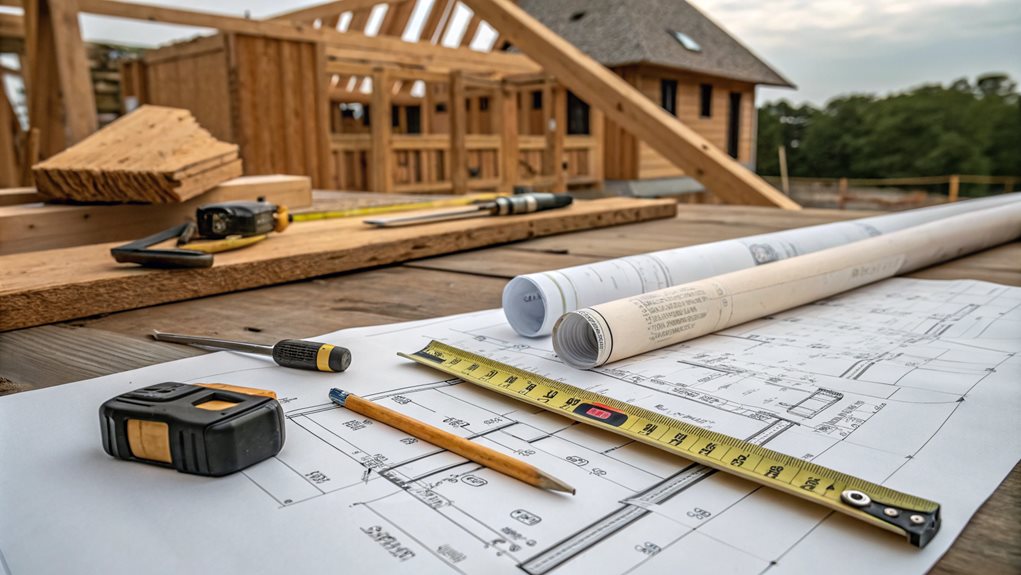
Adherence to local building codes is a fundamental requirement when constructing a deck, as these codes are essential for guaranteeing the safety and legality of the structure. These codes vary widely based on the municipality, influenced by unique geographical factors like climate and soil type.
To comply, consider the following:
- Footing Requirements: Codes might specify footing depth and width to account for frost lines and soil stability.
- Structural Component Compliance: You'll need to align with regulations for support posts, including their attachment and material specifications.
- Pre-Construction Consultation: Engage local building officials early to validate all planned elements meet requisite codes.
- Inspection and Approval: Obtain necessary approvals before construction initiation to avoid legal repercussions.
Choosing the right decking materials not only enhances the aesthetic appeal but also aligns with structural standards crucial for safety and longevity. Understanding these guidelines fosters a sense of belonging within a well-built community.
Deck Building And Design FAQ
What Is the Best Software for Deck Design?
Aztek Deck Designer stands out for its excellent graphics, customizable features, and user-friendliness, making it ideal for creating detailed deck designs. Its simplicity and expansive options foster a sense of community among those seeking extensive design solutions.
How Do I Calculate the Cost of My Deck Project?
To calculate the cost of your deck project, consider deck size and materials, labor costs, permits, and contingency funds. Use software for precise estimates, incorporate local codes, and ascertain all structural support elements are accounted for.
What Safety Features Should I Include in My Deck Design?
Incorporate safety features such as compliant railings and guardrails, adequate height per local codes, and stable, weather-resistant materials. Regular safety inspections and non-slip surfaces enhance security, providing a safe and welcoming outdoor space for all users.
How Can I Ensure My Deck Is Environmentally Friendly?
To guarantee your deck is environmentally friendly, prioritize sustainable materials, implement energy-efficient design, integrate effective water management, and plan for waste minimization. Opt for certified products and local sourcing to support eco-friendly practices and foster community sustainability.
What Are the Popular Deck Design Trends This Year?
Popular deck design trends this year emphasize multi-level layouts for versatility, integrated eco-friendly seating, and seamless fire pits. Also trending are outdoor kitchens for elevated dining experiences and innovative lighting schemes that enhance aesthetics and functionality.

